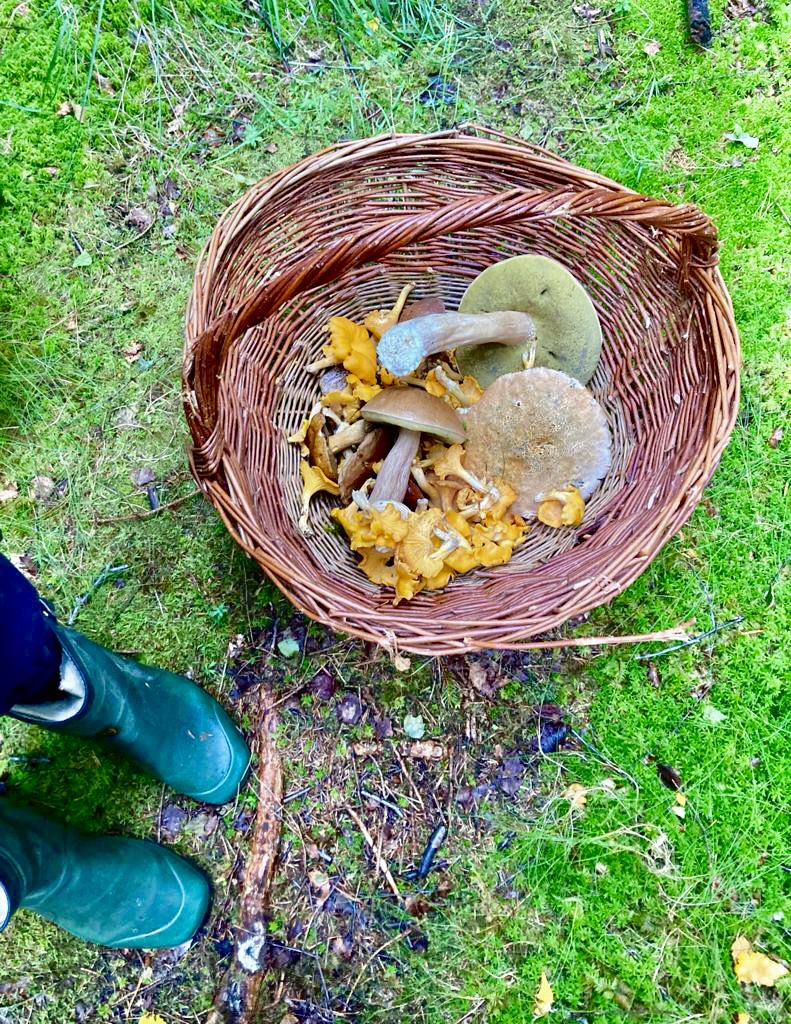Mushroom Collectives in Scotland.
It’s August, and harvest season approaches. This year, a bumper crop of mushrooms in the forest has made me think about what abundance is, and we what we need to feel that we are living well. I’m lucky to be safely walking in the forest, but at the back of my mind I know that this is something to be grateful for. I know that if I was back home in Canada, the forest might be unsafe or unrecognizable after this summer’s deadly wildfire season from climate change impacts. Just this year, more land has burned than ever recorded before in history. July was the hottest month globally in the last 125,000 years.
Celebrating Writing and Reading
ROBIN WALL KIMMERER: Braiding Sweetgrass
MERLIN SHELDRAKE: Entangled Life
ANNA TSING: The Mushroom at the End of the World
EUGENIA BONE: Mycophilia, Revelations from the Weird World of Mushrooms
It seems a privilege to almost avoid the issue, to take the time to move slowly through the forest searching for mushrooms. It’s a pure and childish form of joy to find something edible, new, and colourful, where the day before was bare ground. However, I know that connecting to food and the diversity of nature draws on a long political and social history. Feminism has always been concerned in the ways we live life under capitalism and patriarchy. These systems of power challenge our ability to express ourselves, safely connect with each other, and live sustainably with care for all beings. Conditions of hierarchy and oppression, forcing us into a constant need to work for profit, separate us from each other and nature. This disconnection leads to our negative well-being.
Until very recently, mushrooms and fungi were considered extensions of plants rather than being recognised as their own species. Still today, relatively little research funding is allocated to their study, and historically they have been considered anti-Western science. Women, often labelled witches, mostly carried knowledge of edible and medicinal mushroom identification.
Indigenous communities in South America were vilified for their ritual use of mushrooms, and in North America most mushrooms are harvested by migrant and Indigenous communities living in the forests of the Pacific Northwest. Living a life close to mushrooms often requires living outside of capitalist and patriarchal systems of industrial food production and “scientific” knowledge. It also brings us closer to nature’s food systems and the communities that form around them. This supports our capacity to live well and connect with one another more positively.
Mushrooms themselves push the boundaries of patriarchal, capitalist conceptions of predictable and measurable categories. Western scientific rationality, a system of enquiry that separates the world into binary labels to “prove” systematic theories, fails to explain the unpredictability of mushroom behaviour! Mushrooms grow at random times, in random places, and are linked by hidden underground webs of life called mycelium. Sometimes, they sprout in places once and then are never seen in that location again. Though the reasons for migrating are still unknown, mushrooms are the fruiting bodies of these huge, interconnected mycelia, not individual beings rooted in one place. They are non-binary and do not fit into a scientific viewpoint that categorises beings into male or female. There is no objective assessment of what a mushroom is and how it expresses its gender. They are often erased from -or treated with fear in- traditional education, research, conservation, and use. Most mushrooms can’t be cultivated on farms, so their global trade is hidden in informal spaces of gathering and selling. This echoes women’s labour around the world, often hidden but crucial to societies’ survival.
In the current context of the climate crisis, the act of mushroom picking should be just as radical as mushrooms themselves. Not everyone has access to forests for picking or time for searching. And, if everyone were to switch to a foraged diet, our habitats would not be able to sustain it.
Queer theorist Sara Ahmed says feminists “[their] gut instinct senses when something is amiss.” I think both feminism and fungi teach us lessons in how to challenge a system in which we feel amiss; unwell, unhappy, and unsustainable. We can be mindful of how much we need and consume within ecological limits. We can think about the ways we are all interconnected with each other and nature. The result? (radical) care for each other. Finally, we can be unafraid to dismantle a capitalist, individual, and binary system. Mushrooms have been known to take down manmade buildings and clean up oil spills. I think we can learn a lot by coming together to imagine a better life completely outside what we have grown up in, rather than trying to reform what we have. Feminism teaches us these lessons of challenge and imagination, too, as Audre Lord says: “the master’s tools will never destroy the master’s house.” Returning to nature’s food systems can positively connect to our feminist values of community, care, and connection.










Leave a Comment